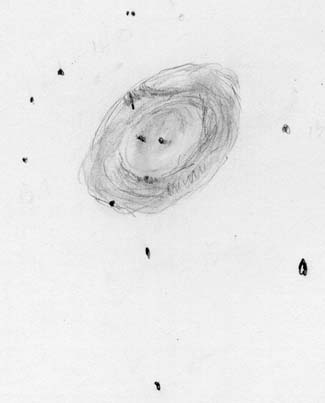

White Oaks Home | Sketches Index | Back | Next
Discovered by Antoine Darquier de Pellepoix in 1779, the famous ring nebula M57 is often regarded as the prototype of a planetary nebula, and a showpiece in the northern hemisphere summer sky. Recent research has confirmed that it is, most probably, actually a ring (torus) of bright light-emitting material surrounding its central star, and not a spherical (or ellipsoidal) shell, thus coinciding with an early assumption by John Herschel. Viewed from this equatorial plane, it would thus more resemble the Dumbbell Nebula M27 or the Little Dumbbell Nebula M76 than its appearance we know from here: We happen to view it from near one pole.
My sketch revealed two stars in the center. The mag 15.7 central star, a planet-sized white dwarf, and a fainter companion. I also observed knots and bright spots in the shell around the star. Mike and Dave the telescope operators pulled up Brian Skiff's Ring Nebula photometry and we compared my sketch to the chart. I saw and sketched the mag 14.7 and 14.9 double stars north of the planetary nebulae, and the mag 15.6 star on one side. Note: a friend took the JPG of the sketch and inverted it in photoshop. It is not the way I sketched it, and I don't invert my sketches. I don't really like inverted by software sketches as it is not how I sketched it - if you see this, send me your opinions!
Here's a nice chart for this project. 240X using the 100mm (4-inch diameter) Masiama Kellner eyepiece. 400x using the 4-inch diameter 60mm Erfle.
|
|
|
|
White Oaks Home | Sketches Index | Back | Next
|